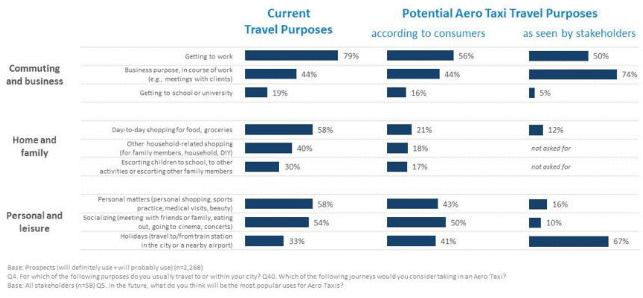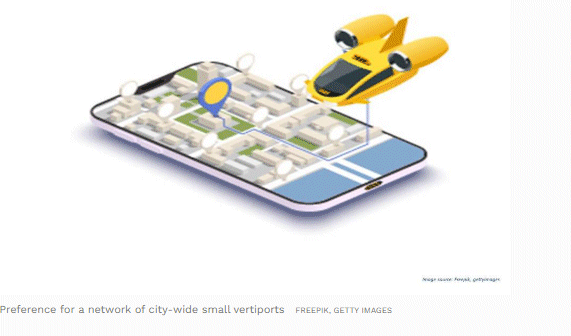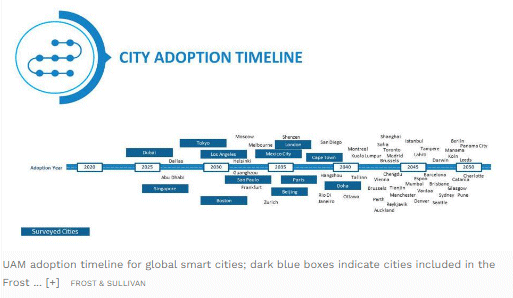Flight of fancy? No more. The mobility disruption is all set to takeoff…skywards. A pioneering global survey by Frost & Sullivan on urban aero mobility (UAM) highlights that the day when air taxis will become as commonplace as your standard black cab isn’t that far off. Consider that by 2040, there will be an estimated 2.5 million aero taxi units flying in over 30+ cities. I can’t say I am surprised. After all I don’t think there are many of us who wouldn’t rather wing it to work than undergo another crawl through congestion. My real interest (besides the selfish one of knowing where I must move in 2040) in the study’s findings lie in understanding what will really drive this market, whether in terms of customer willingness to get onboard an aero taxi and how much they will be prepared to pay for the service as much as why supply chain stakeholders are optimistic about the operational and financial feasibility of this emerging business model.
Here’s a sneak peek into some of the findings from the survey which covered nearly 5,000 respondents drawn from a representative sample of 12 smart cities. They included both those living and traveling within a city to those living outside a city and traveling to it. The study also covered multiple stakeholders across the UAM value chain including companies, subsystem manufacturers and service providers in automotive and aircraft domains.
Time Savings Emerge As A Major Consideration
Any discussion about UAM must crucially begin with the question: is it viable? As in any new and evolving technology / market, there are as many opinions as there are, well, birds (metal or otherwise) in the sky. Sceptics point to the limited deployments of small drones, citing complex regulations and user accountability as the main impediments. Supporters, meanwhile, showcase the increasing penetration of drones in varied industries and applications underpinned by maturing technology and progressive regulations.
While most stakeholders in the survey appear positive about the potential for aero taxis in the future, most concede that cargo operations – which have fewer regulatory and certification complications – will likely be the first commercial applications of UAM with unmanned and, eventually, autonomous aircraft platforms debuting before passenger transport operations.
In a promising sign, almost half the consumers in the survey declare that they will definitely or probably use air taxis as a transportation option in the future. Interestingly, barring the cohort of respondents aged 50 years or older, potential customers in other age groups seem positively inclined towards aero taxi use. This is an important finding since it implies that there will already be widespread consumer acceptance by the time aero taxis become a norm in our skies.
And what will these customers be using aero taxis for? With even the occasional work commute proving time consuming during the ongoing pandemic, it hardly comes as a shock that customers pick commuting and business travel as the leading applications for which they will use an aero taxi.

Irrespective of application, demand will be high. In all probability, therefore, vehicles will be designed to be adaptive and accommodate dual or even multiple applications, swapping between cargo, manned or even emergency services tasks in a modular approach.
Different vehicle utilization rates (one, two or four passengers), different purposes (long-distance intercity and mid-distance intracity journeys), different user preferences (shared or personalized and autonomous or piloted), and different terminal structures (dispersed or centralized), will add to the complexities confronting stakeholders. So where should they be focusing their energies?
Based on respondent feedback, I believe the skies will soon be buzzing with a mixed fleet of aero taxis that fit two and four passengers. A network of city-wide small vertiports would appear to have greater appeal than one, large centrally located vertiport, while user preferences in terms of shared or personalized modes will vary by distance and city.

It’s A Scrum Down Here To Be The First To Get Up There
Today, the UAM market has more action than an Avengers movie. Earlier in July, Airbus’s aero taxi platform – CityAirbus – conducted its first public demonstration. In September, Lillium signed an agreement with both Dusseldorf Airport and Cologne / Bonn Airport to explore regional air mobility network options. Hyundai’s UAM division recently joined the General Aviation Manufacturers Association (GAMA), earlier in the year the Korean automaker became the first automotive company to join Uber Air’s Elevate initiative. Kitty Hawk, Volocopter, Terrafugia, Joby Aviation, Airbus, EHang, Boeing BA +1.9%, Bell, and, lest I forget, even NASA with its Grand Challenge, are all in a race to convert UAMs from reel fantasy to everyday reality.
For many stakeholders, battery energy density limitations present a key short-term challenge. Intercity journeys of more than sixty minutes may depend on hybrid vehicles in the coming decade. However, if one takes Elon Musk at his word—that battery-powered urban aviation may be available in 3-4 years—such barriers will be resolved sooner than anticipated. Companies like the Electric Aviation Group (EAG) and Hyundai in partnership with Uber Air, among others, are already forcing the pace on developing commercially viable electric propulsion solutions.
Take Your Pick of Cities
The UAM survey, part of a larger study focusing on 175 Smart Cities, zeroed in on a representative set of 12 cities. So take your pick….

The survey spotlights Los Angeles, alongside Dallas and Boston, as one of the early adopters of UAM in the US, led in no small measure by Los Angelenos who put their city at the top in terms of consumer attitudes towards air taxis as a unique, attractive concept. The city features as among the first where Uber Air will trial its air taxis. From a host destination perspective, the City of Los Angeles has been proactive in teaming up with the World Economic Forum (WEF) to release a roadmap supporting the rollout of UAM in cities.
As underlined by the Dubai Road Transport Authority’s (RTA) collaborations with EHang and Volocopter, Dubai has been a pioneer in testing electric vertical takeoff and landing (eVTOL) technologies for launching an air taxi service. Air taxi operations are anticipated to begin on a limited scale by 2022, with commercial operations expected as early as 2025.
Much like Dubai’s experiments with aero taxis, São Paulo’s famous heli-taxi operations provide it with the perfect springboard to extend its existing heli-taxi infrastructure and operational best practices to launch eVTOL-based air taxi operations. São Paulo seems like a natural fit as it is already the helicopter commuting capital of the world.
The high cost of public transportation and relatively long average commute times are likely to add momentum to UAM initiatives in London and Singapore. The UAM revolution is on track for liftoff in all these cities, together with others like San Francisco, Paris, Rio de Janeiro, Vancouver, and Dallas.
Charting A Flight Plan For The Future
By 2051, most of 175 smart cities in the survey will have UAM operations, meaning that this is a market hard to ignore. However, before looking to the skies, I’d advise some essential groundwork.
Firstly, profitability for the aviation industry is hard at the best of times and even harder since the pandemic broke. While the survey makes clear that the UAM business will be lucrative, stakeholders need to gauge customer willingness to pay a threshold price when using UAM services, ensuring that it is pegged above the cost per flight hour (CPFH). Stakeholder responses in the study indicate a positive outlook.
Secondly, stakeholders will need to establish a robust physical and digital infrastructure to support thousands of low-flying aircraft in a crowded airspace (below 400-500 feet). Such infrastructure planning will also need to account for the rising deployment of small drones in a wide range of applications.
Thirdly, a critical pre-requisite will be to create a regulatory framework that allows for the integration of safe platform and operating procedures.
Fourthly, the aviation industry will need to dramatically rethink and overhaul its supply chain to ensure that it effectively serves large-scale demand. In this, it has much to learn from its automotive counterparts. Synergizing their learnings – whether in terms of certification or product development – will require sustained collaboration between automotive and aviation industries.
Lastly, there’s the question of determining who will be the dominant player in the UAM universe: the companies or the cities themselves? If you chose the latter, then you’re echoing the views of a majority of the customers in our survey.
Fast forward to a decade later. Instead of reading this article at your office desk, you’re probably reading it while hovering a few hundred feet above your city, getting ready to land outside a vertiport next to your office.
This is one dream that I am looking forward to becoming a reality in my lifetime.
Article was originally published on Forbes.com



